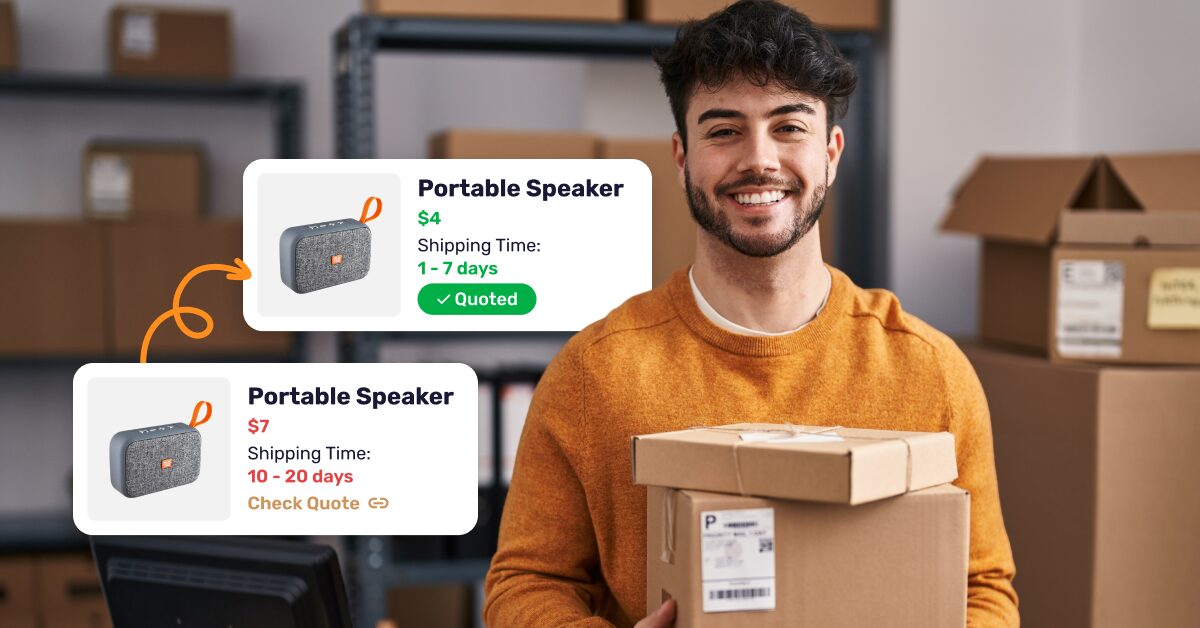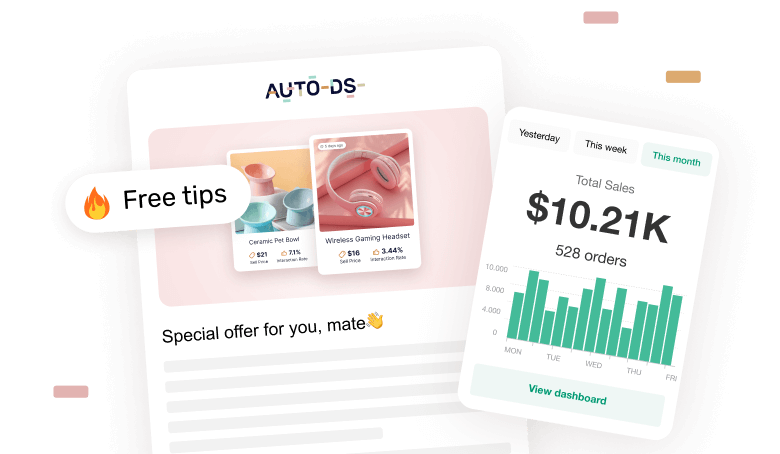If you’re building an online store, you need products to sell. And getting those products is what we call product sourcing. But what is this, exactly? It’s the art and science of finding, evaluating, and securing products to sell in your store. This can be done manually, but platforms like AutoDS simplify product sourcing with automation and AI tools.
Don’t know where to start? No worries, here’s the product sourcing 101 that’s going to help you along the way. We’ll break down all the major ways to source products, step-by-step instructions to help you do it like a pro, and how automation tools can make the whole thing a lot easier.
Product sourcing is the foundation of your store’s success. It impacts everything from shipping times to profit margins and customer satisfaction.
There are multiple sourcing methods to choose from, including one-click automation, private suppliers, and wholesale, each with its own pros and cons.
AutoDS simplifies sourcing with powerful tools like the AI Product Finder, one-click importer, and supplier marketplace, making it easy to find, test, and sell winning products.
What Is Product Sourcing?
Product sourcing is more than just picking the best items to sell. It’s the entire process of finding, evaluating, and partnering with suppliers to stock your online store. This involves figuring out a few things:
- Where will your products come from? Are you looking for Chinese products or US-based vendors?
- How will you get them? Through dropshipping, wholesale, print-on-demand, or something else?
- Who will you trust to deliver them to your customers? Do they offer fast, reliable shipping? Do they have good reviews?
A common misconception is that you can sell any product from any supplier and expect great results. But here’s the harsh truth: not all suppliers are reliable, and not all products are worth your time. Sourcing isn’t just about what looks good. It’s about what sells easily, ships reliably, and leaves your customers happy.
If you don’t take product sourcing seriously, you’re basically inviting late deliveries, poor quality, slim margins, and unhappy customers. And when you get it right? Fewer headaches, better reviews, and way more repeat buyers. It’s one of those behind-the-scenes steps that makes a huge difference and sets the tone for your entire business.
Types of Product Sourcing Methods
There’s no single magic formula when it comes to product sourcing. There are multiple ways to go about it—some are easier and more efficient, some are free or low-cost, and others require more time, money, or hands-on work. The key? Finding the method that fits your goals, budget, and experience level.
One-Click Sourcing With Tools Like AutoDS
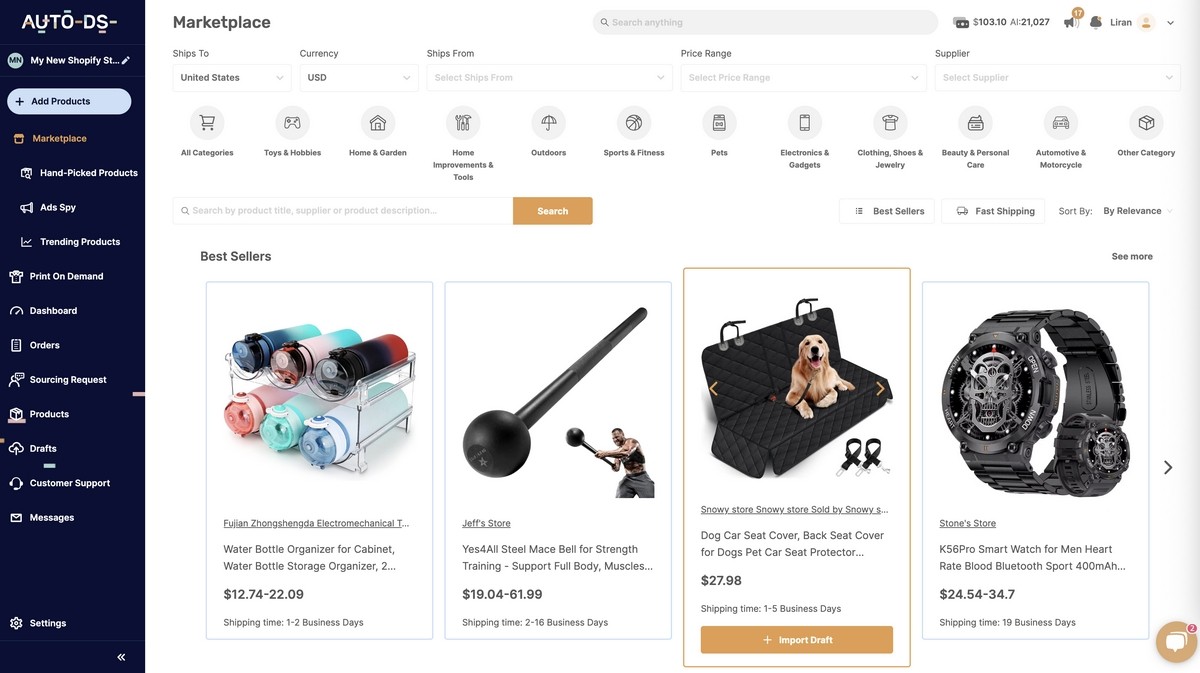
Nobody wants to deal with the messy stuff of sourcing. The way to go? Automation. AutoDS, the all-in-one dropshipping platform, makes sourcing feel like a breeze with automated tools that help you find, assess, and import winning products.
Specifically, AutoDS gives you access to a curated marketplace where you can filter by shipping speed, price, supplier rating, and more. And that’s not it. You can also import products straight into your store with just one click. No manual copy-pasting, no spreadsheets, no stress.
Pros:
- Super fast and beginner-friendly.
- Built-in filters to find trending, high-quality products.
- Auto-updates for stock and price changes.
- AI-optimization tools for product titles and descriptions.
Cons:
- There’s no free plan, so it requires a monthly subscription.
All in all, AutoDS is ideal for dropshippers looking to scale and make money faster, as automation helps accelerate the entire dropshipping workflow.
Manual Sourcing From Marketplaces (AliExpress, Amazon, etc.)
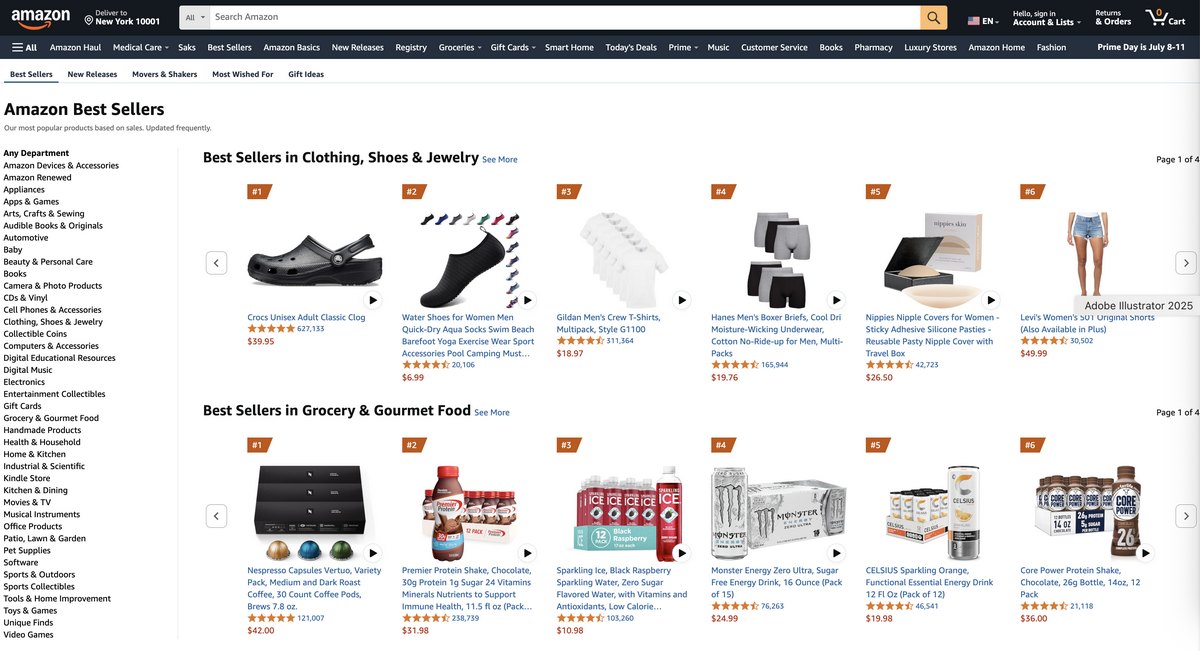
Manual sourcing involves browsing marketplaces to find individual products and suppliers, then adding them to your store manually (meaning, copying and pasting all the details, including photos and videos). You basically navigate through AliExpress, Amazon, eBay, Shein, and other major marketplaces to find best sellers and items in demand.
Pros:
- Full control over product selection.
- Huge variety of suppliers and niches.
- Free of charge.
Cons:
- It’s time-consuming. It can take hours or days to build your catalogs, and they need constant updating.
- Harder to track inventory and price changes manually. The bigger the catalog, the harder it is to keep up with.
- Prone to errors. With so much copy-pasting and manual uploading, things can get messy.
Manual sourcing is best for small sellers who don’t want to invest in tools yet and don’t mind doing things manually.
Private Suppliers And Agents
Sourcing through private suppliers and agents means you partner with them to find and fulfill products for your store. In this case, you’re putting your efforts into creating partnerships that do the sourcing for you.
Pros:
- Lower per-unit costs.
- Better quality control.
- Custom packaging and branding options
- Reliable long-term relationships.
Cons:
- Takes more time to vet and negotiate.
- Usually requires a minimum order or sales volume, making it a long-term commitment.
Sourcing through private suppliers or hiring an agent is best for experienced sellers ready to scale in the long term or those building a strong brand.
Print On Demand (POD)
Print-on-demand means you design the product (think t-shirts, mugs, or caps), and a third-party supplier prints and ships it only after a customer places an order.
Pros:
- No inventory needed.
- Great for custom, branded designs.
- Easy to test new ideas.
- Useful for specific niches—think sports team enthusiasts, pet lovers, or fans of pop culture trends.
Cons:
- Lower profit margins.
- Slower fulfillment times.
Print-on-demand is best for creative entrepreneurs, artists, or influencers with a strong personal brand.
Wholesale Sourcing
Wholesale sourcing means you buy products in bulk at discounted prices from manufacturers or distributors, store them yourself (or use a fulfillment service), and ship them out as orders come in.
Pros:
- Higher margin sales.
- Full control over inventory or packaging.
Cons:
- Requires upfront investment.
- You’re responsible for all the logistics, including inventory, storage, and shipping.
All in all, it’s best for sellers with enough budget to make an upfront investment and the ability to manage logistics.
Retail Arbitrage
Retail arbitrage is about finding discounted products at local or online retail stores and reselling them for a profit. Sounds like dropshipping, right? But there’s a major difference: with retail arbitrage, you buy and hold inventory, then handle the packaging and shipping yourself, unlike dropshipping, where the supplier ships the product directly to your customers.
Pros:
- Low startup costs.
- Higher profit margins.
Cons:
- Not scalable compared to dropshipping.
- You manage all logistics, like inventory, storage, and shipping, which is time-consuming.
Overall, it’s best for sellers looking for great deals and short-term wins.
Domestic vs. International Sourcing
This refers to where your products are coming from, either within your country (domestic) or from abroad (usually China or India).
Domestic Sourcing
Pros:
- Faster shipping.
- Easier communication and returns.
- Higher quality products.
Cons:
- Higher costs for both products and shipping
Domestic sourcing is best for local stores focused on customer experience, fast delivery, and higher quality products.
International Sourcing
Pros:
- Lower costs.
- More product variety.
Cons:
- Longer shipping times.
- Possible customs delays.
- Product quality varies, so it requires careful vetting.
So, who is it best for? Mostly, stores looking for variety and better margins.
How to Source Products to Sell Online: Step-by-Step
Now that you know your options, let’s walk through the actual process of sourcing products to sell online the right way, from idea to execution.
Choose Your Niche
Before you even think about finding dropshipping suppliers, zoom out: What kind of store are you building? Is it a cozy decor shop? A pet lover’s paradise? A fitness gear brand? And are you going broad (like home goods) or targeting a specific niche (like eco-friendly kitchen tools)? Your niche shapes everything, from the products you pick to the people you market to.
Go for a niche you understand or are genuinely interested in. It will make research and marketing way easier.
🆕Beginner’s Tip: Here are the best niches for dropshipping in 2025 to help you kickstart your dropshipping business.
Identify Product Trends
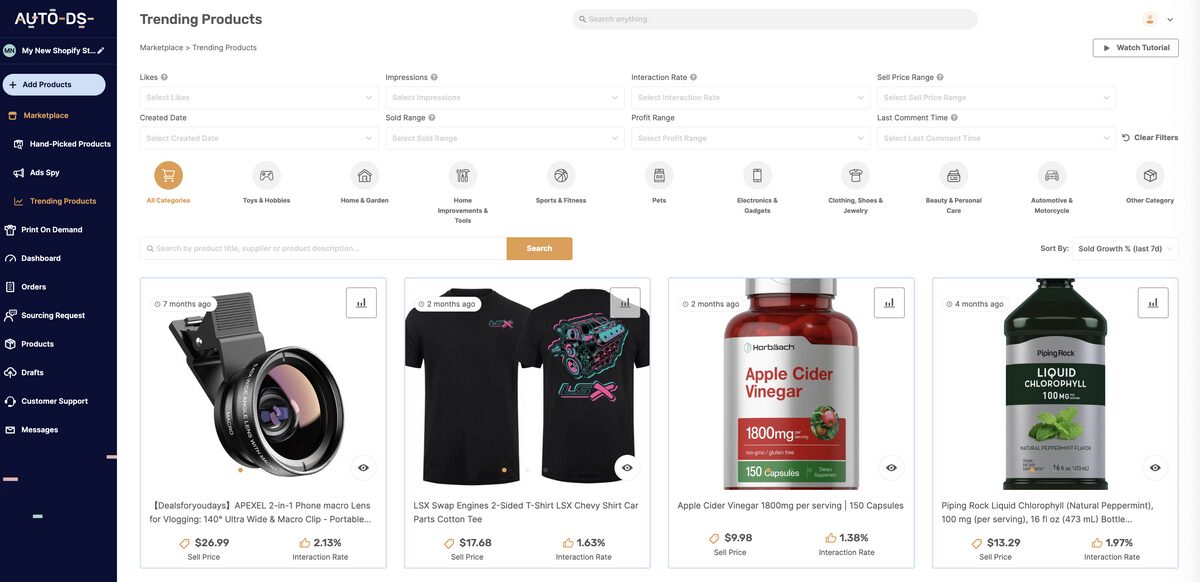
Now, it’s time to figure out what’s trending. Browse TikTok, scan Amazon Best Sellers, dig through Google Trends, or use AutoDS’ product sourcing tool and ad spy to see what’s hot right now. Look for products that solve a real problem, look good in photos, or have that viral vibe. Just make sure the trend hasn’t already peaked.
Research Suppliers
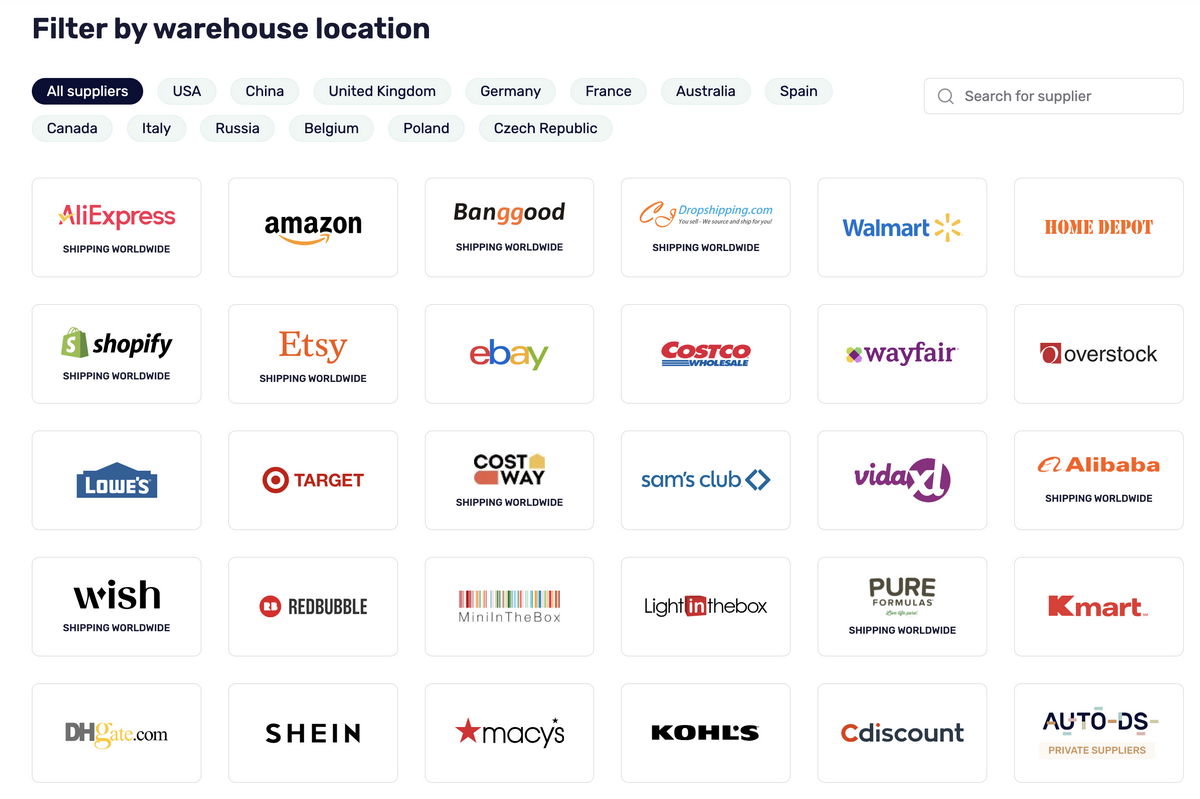
Found a product idea? Great. Now let’s find someone reliable to supply it. Whether it’s AliExpress, a private agent, or AutoDS’s vetted supplier network, your supplier should check three boxes:
- Solid reviews
- Fast shipping
- Good communication
A good product with a bad supplier = a customer service nightmare. Don’t skip this step or take it for granted. Do your research, pick your supplier method, and test.
Evaluate pricing, quality, and shipping
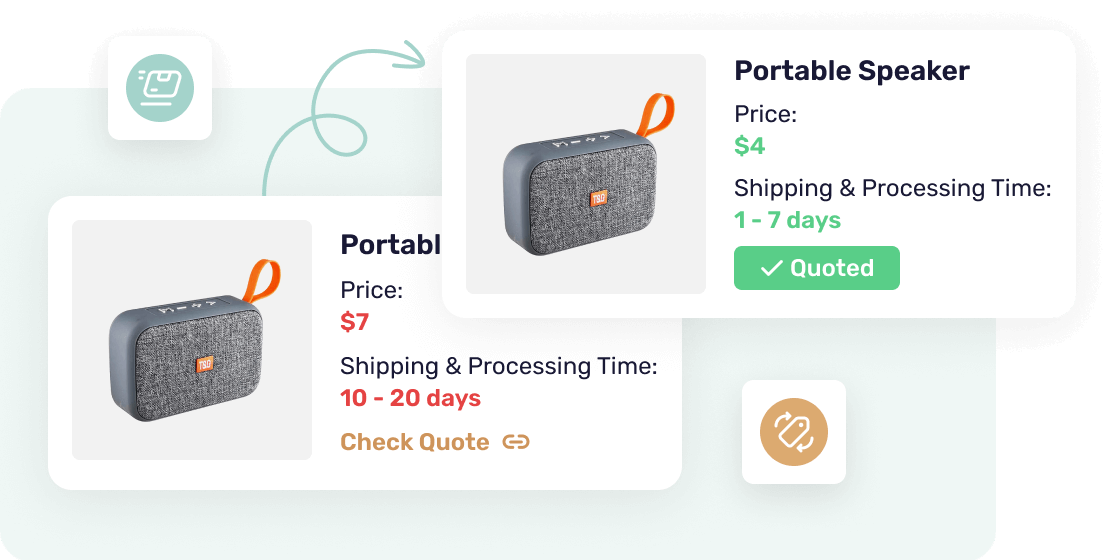
This is where you do the math. Compare suppliers and make sure the product quality, shipping time, and pricing actually work for your business. Watch out for long processing times, inflated shipping fees, and vague return policies.
📦Supplier’s Tip: Always get samples from your suppliers when you can. This will let you assess quality, shipping times, and packaging. Seeing it in person saves you from surprises (and complaints).
Use automation tools

Here’s where it gets interesting. Because you don’t need to do everything manually, nor should you. Using automation dropshipping platforms like AutoDS can help you:
- Import products in one click
- Set pricing rules that protect your margins
- Keep inventory, prices, and shipping info up to date (automatically!)
- Automatically fulfill orders
In short: less busywork, more growth.
Check out this AutoDS product sourcing vs competitors comparison to learn how it stacks against Spocket, CJDropshipping, and DSers for smarter dropshipping.
Test and analyze
You don’t need 100 winning products, you need ✨the one✨ that converts. Run some ads, track your sales, and pay attention to customer feedback.
The formula’s pretty simple: If something flops, let it go. If it works, double down.
How AutoDS Helps with Product Sourcing
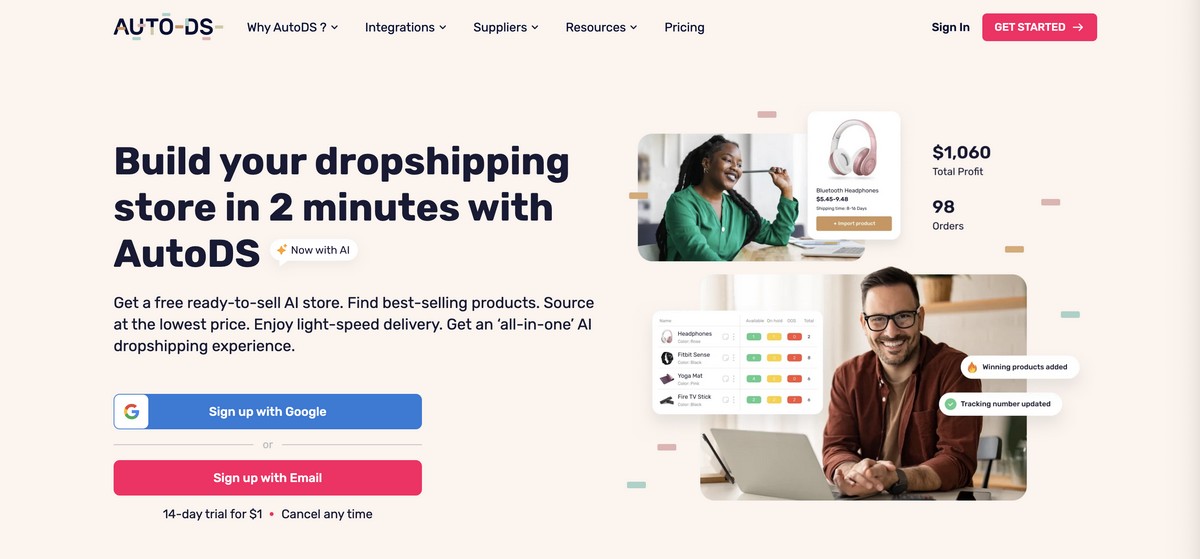
Product sourcing doesn’t have to be a time-sucking maze. Manual sourcing makes sense when you’re just starting out with a small catalog. But once it starts to get a bit more serious, you need to scale and grow.
That’s where AutoDS comes in. Instead of juggling multiple suppliers, spreadsheets, and shipping details, you can manage everything from one single place. As an all-in-one dropshipping platform, AutoDS gives you the tools to find, test, and sell winning products (without the chaos).
Here’s how AutoDS makes sourcing easier, faster, and smarter:
- AI product finder: Let the algorithm do the hunting. AutoDS’s AI scans millions of products and suggests winning items based on performance, trends, and niche. No need to navigate through the deep end of product sourcing.
- One-click importer: Literally, just a URL copy-paste kind of thing. See a product you like? AutoDS lets you add it to your store instantly, automatically picking up on titles, descriptions, images, pricing, and variants. And you can import multiple products from different suppliers at once.
- Supplier marketplace integration: AutoDS allows you to access and manage a wide range of top suppliers like AliExpress, Amazon, Walmart, Costco, eBay, and more, right from a single dashboard. Compare options, shipping times, and pricing in seconds.
- Product variants tool: Offer multiple colors, sizes, and styles without the hassle. AutoDS keeps all variants organized and synced, so customers can choose what works for them.
- Price and stock monitoring: Never get caught off guard. AutoDS automatically updates your store when a supplier changes the price or runs out of stock, so you don’t have to babysit listings.
- Product tags and filtering: Easily organize your product catalog with tags like “Fast shipping”, “High profit”, “Trending”, or whatever works best for you. Then, filter by tag to quickly manage or promote the right items.
- Automation features: From order fulfillment to price adjustments and tracking updates, AutoDS automates the boring, time-consuming stuff so you can focus on growing your store.
Ready to level up your strategy? Try AutoDS’s Product Sourcing Tools now with our 14-day trial for $1
What Kinds of Products Can You Source?
Here’s the fun thing about dropshipping: when it comes to sourcing, you’ve got options. Tons of them. From viral TikTok finds to timeless best-sellers, here’s a breakdown of the types of products you can add to your store, and what makes each one worth considering.
Trending Products
These are hot, “everybody-want-it-right-now” items that pop fast on marketplaces and social media and sell even faster. Trending products drive traffic, build hype, and give you quick wins, especially when you jump early.
Think the latest lipstick shade going viral, a new fidget toy everyone’s playing with, or the ultimate pet grooming tools going crazy on TikTok. Just keep in mind that trends move fast, so be ready to switch things up if the hype dies down.
Seasonal Items
Seasonal products are items that sell best during specific times of the year. For example, swimsuits in summer, Halloween stuff in October, and holiday decorations in December.
Seasonal items are gold for dropshipping stores because shoppers are actively looking for them, and they want them now. And the best part? They’re predictable (no need to overthink it) and can definitely increase sales if you time it right.
💡Pro Tip: Start sourcing seasonal items at least 4-6 weeks ahead to beat the rush and stay one step ahead of your competitors.
Evergreen Products
Evergreen products are items that sell all year round. They are reliable, creating a consistent, stable income for long-term growth. Think water bottles, phone chargers, yoga mats, or skincare basics, meaning things people need or want regardless of the season.
📢 Marketing Tip: Many evergreen products can be bundled, upsold, or offered in multiple variants. For instance, if you sell a phone charger, why not bundle it with a phone case or headphones?
High-ticket vs Low-ticket Products
Both high-ticket and low-ticket products work; you just need the right strategy.
- High-ticket products are items with a higher price point, usually $100 or more. Think home gym equipment, premium kitchen appliances, and technology gadgets. These bring fewer sales, but higher profit margins. Great if you’re confident in your marketing game.
- Low ticket products are items with a lower price point, usually below $100, that offer more sales with a smaller profit margin. These sell fast, appeal to impulse buyers, and are perfect for testing trends. Just make sure your margins can handle shipping and marketing costs.
Niche Products: Fashion, Electronics, Home, Beauty & More
Niches are the fun (and super profitable!) part of dropshipping. Niche products let you get creative and build a store that feels like you. Instead of trying to sell to everyone, you’re focusing on a specific group of people with shared interests or needs.
Love pets? Are you a fan of Nordic home decor? Want to target fitness enthusiasts? Honestly, the possibilities are endless. Do your research, pick a niche, and go for it. The more you’re into this niche, the better—you’ll know exactly what sells and how to market it.
And this is the magic about niches: there’s less competition, more loyal customers, and you just stand out. If you want to build something with personality (and not just another generic shop), niche products are the way to go.
Here are some popular, profitable niches with items you can sell:
- Fashion and accessories – jewelry, bags, loungewear, activewear.
- Tech and electronics – phone accessories, smart gadgets, LED lights.
- Home and kitchen – storage hacks, cookware, decor.
- Beauty and wellness – skincare tools, hair products, fitness gear.
- Pets – toys, grooming tools, cozy beds.
- Baby and kids – learning toys, baby safety gear, clothes.
You can focus on one category or test a few. There’s plenty of room to find what works best for your audience.
Ready to own your niche like a pro? AutoDS’s dropshipping niche guides help you find what’s trending, source smarter, and scale fast. Just find your niche and you’re good to go.
Best Practices and Mistakes to Avoid
Sourcing products to sell online sounds simple, but a few common mistakes can seriously hurt your profits (and your sanity). Here’s what to watch out for, plus how to do it right.
Choosing Suppliers Without Checking Reviews
Not all suppliers are the same. Some are really good, while some fail on communication, transparency, quality, shipping, or all of them. If you skip the research and go with the first one you find, you risk slow shipping, low-quality products, or terrible communication.
👉 So, now you know: the first step of your research? Reviews. Bonus points if you order a sample to test the product (and the delivery experience) yourself.
Not Analyzing Profit Margins
A product might look like a winner, but if your costs eat up most of the sale price, you’ll be working hard for pennies. You have to take into account the cost of the product, shipping, fees, marketing, and every single expense associated with it.
👉Do the math before you list anything. Know your break-even point, and aim for products with healthy, realistic profit margins.
Ignoring Shipping Times
Fast shipping matters, especially in a world where Amazon sets the bar. Long delivery times mean frustrated customers, negative reviews, and refund requests. Why ignore this when you can just pick suppliers with good shipping times?
👉 Use filters (like the ones in AutoDS) to sort by shipping speed. Also, look for local suppliers with fast delivery options. If you’re targeting US shoppers, look for US-based suppliers. Same for other regions: targeting Europe, for example? Then partner with European suppliers.
I know what you’re thinking: finding suppliers across the globe might sound like a headache. But that’s where dropshipping platforms come in. AutoDS, for example, includes more than 30 global suppliers from all over the world, from the US and China to Europe and Australia, making local shipping not just possible, but easy.
Relying Too Much On One Method
Crushing it with one-click sourcing? Or maybe loving print-on-demand? That’s great. But putting all your eggs in one basket can backfire if trends shift or a supplier changes something.
👉 A tip? Test multiple sourcing methods when possible. This gives you flexibility, better product variety, and a backup plan if things change.
Failing To Adapt To Trends
Once your listings are working fine and revenue is flowing like your morning coffee, it’s easy to get comfortable. But here’s the tip: don’t. Just because a product used to sell doesn’t mean it will sell forever. Trends change, customer behavior evolves, and the best stores adapt with it.
👉 Keep your sourcing fresh. But no worries, this doesn’t have to be complicated. Tools like AutoDS help you stay ahead of the curve and spot new sourcing opportunities constantly.
Frequently Asked Questions
How can I get products for my online store?
You can get products for your online store by using various methods like working with dropshipping suppliers, purchasing from wholesalers, sourcing directly from manufacturers, attending trade shows, or making your own products.
How can I find reliable suppliers?
Finding reliable suppliers means checking quality, shipping times, reviews, and return policies. Do your research through reviews and ratings, and check out AutoDS’s suppliers page for trusted options.
What is the best method for sourcing products for dropshipping?
The best method for sourcing products in dropshipping depends on your business needs and preferences. Working with a reliable dropshipping supplier or using AutoDS Marketplace, which provides access to multiple trusted suppliers, can be effective methods.
What does Shopify sourcing mean?
Shopify sourcing is the process of finding and adding products to a Shopify store from various suppliers or sources. It involves sourcing products from different channels to populate a Shopify store with diverse inventory for selling online.
How does AutoDS help with product sourcing?
AutoDS simplifies product sourcing with tools like the AI Product Finder, one-click product importer, supplier integrations, price and stock monitoring, and automation. In addition, the AutoDS Marketplace gives access to exclusive private suppliers and unique products worldwide. These features help you discover trending products, test ideas quickly, and scale your store without manual effort.
What types of products should I source for my dropshipping store?
When dropshipping, consider sourcing products that are in demand and trending, priced competitively with room for profit, and that solve a problem. Make sure to include items from popular categories such as home improvement, beauty, pet supplies, tech accessories, and fitness gear. We’ll be covering each product type in future guides linked from this page.
Conclusion: Master Product Sourcing
Product sourcing isn’t just a checkbox—it’s the heart of your dropshipping store. From finding trending items to choosing the right suppliers, every decision impacts your profits, customer experience, and long-term growth.
Think about it: product sourcing comes down to the product that draws shoppers in, the product they receive at their doorstep, and the product that keeps them coming back for more.
Yes, it takes time. But with platforms like AutoDS, you don’t have to do it all on your own. Automation tools give you everything you need to source smarter and faster, from AI-powered product research to one-click imports, automated pricing, and a marketplace full of trusted suppliers.
Try AutoDS’s product sourcing tools and see it for yourself.
And, if you want to become a pro at product sourcing, check out more sourcing-focused articles on the AutoDS blog:






